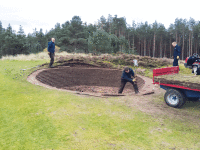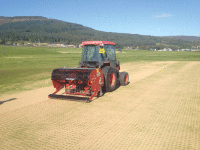Golspie Golf Club - Once more unto the breach!

But paradise was not what Alexander MacDonald discovered when he became Head Greenkeeper in 2007.
Yet, just six and a half years later, the course is somewhere near where Alexander wants it to be. Here, he explains how he got there
I took over at Golspie after I became aware of the vacancy not long after competing in the County Championship there in June 2007. I had previously been at Royal Dornoch and also fortunate enough to have been at Wentworth on the East course working under my uncle, Kevin McGrath. During the prizegiving for the County Cup, I got speaking to the Greens Convenor who was giving a bit of information as to what they were looking for.
Now, make no mistake about it, Golspie was in very poor condition. The greens were very spongy due to excessive thatch and were full of poa and other undesirables. Tees were very uneven, fairways were cut with tractor mounted gangs and bunkers were in need of serious work. There was no definition and, all in all, it was a mammoth task for someone to take on.

How I ever got the job I will never know as, in front of the three person interview panel, I told them that their course was terrible. It had potential but, without some serious investment with the right person leading it, they would forever be in the wake of the other clubs in the area. I told them of the need for serious work on the greens, every bunker on the course had to be redesigned and the course was needing some definition.
Despite slating their course, I was offered the job and, after being told that I would never have a budget - they spent whatever they had coming in - I decided it was a challenge that I wanted, so started on July 9th, 2007

If ever there was a time I wished I'd never touched the job, it was then. Not so much the problems with the greens, just the magnitude of the task in hand - and with only one labourer and a fifteen year old local, Craig Mackay, to call on! Add to that there was no machinery to deal with the problems, except a Sisis Technicore and a tractor mounted slitter, and it was going to be a monumental task.
We got through that playing season, verti-cutting and just trying to make the surfaces playable. We came to the autumn where we could finally get some work done to address the thatch problem. I ordered tines for the Sisis and cored the greens to four inches We then dressed and seeded the greens and, six weeks later, I managed to beg a verti-drain from Royal Dornoch. The greens were done to a depth of ten inches with a ten degree heave. You could almost hear the turf breathing a sigh of relief. I heavy dressed again with a coarse sand and they were then sprayed with T-Thatch and left for the winter.

I managed to persuade a good friend who I worked with at Royal Dornoch and who had moved to Royal Aberdeen, to return home and join me at Golspie. That season, with two 'Craig Mackays' on the staff, the compliments were flooding in as we got everything shaped and a couple of good early dressings on the greens. We were pencil tining greens and getting sand in, and the surfaces were firming up by the day and rolling truer than they ever had done. We also managed to buy a brand new fairway mower and the difference that made was huge, the quality of cut being superb.

In October 2008, I had to attend an interview at the Old Course hotel for an award by Golf Tourism Scotland for the Young Industry Person of the Year. The award ceremony was at the Cameron House Hotel at Loch Lomond and a big awards ceremony it was. I took my deputy, Craig Mackay, with me to the ceremony and never thought I would be in the running for it, but the award came up and my name was announced as the winner. I don't think there is a better feeling than getting an award for doing a job that you love. It gave us both a boost that we were going in the right direction at Golspie and that we should push on and keep improving the course.

Then, in 2011, we entered the Scottish Top 100 Courses; the highest new entry at 69. The committee were trusting us to get on with the job, making any alterations that we felt were needed, whilst anything major would go in front of an EGM.
One major alteration I proposed was to turn the 1st in to a par 5, the original being a 458 yard dog leg left to an elevated green. We moved the tee back to in front of the clubhouse and it is now a 493 yard par 5 that is much more friendly than the previous hole.

I went over on the Saturday during the peak of the storm and seriously felt like six years of hard work had literally been washed away; the course was devastated. I walked about the course seeing jobs that were completed just a few days earlier, ruined and being washed out. The sea was 160 yards beyond the sea defences, waves were throwing rocks - weighing nearly a tonne - around like sweetie papers. It was an incredible force to witness.

The next day, we had over forty people turn up; some were not even golfers, just villagers. I had put an appeal out on the club's Facebook page and they came armed with shovels and barrows. We set off and cleared the worst green - the 5th - where some 5,000 tonnes of sand and stone was lying. It was cleared in a little over four hours.
The rest of the week, with help coming from Skibo, Royal Dornoch, Tain and Bonar Bridge Golf Clubs, the areas that had no water could be cleared. In just four days, it was done.
After our break, we had a visit from the insurers who were suggesting that the only action to take was to strip all the submerged areas. In consultation with the STRI, I pushed to work with what we had by saving the existing turf and keeping the greens as uniform throughout the course as possible.

In the meantime, we had to rebuild our 7th tee in order to get the course playable. We had to reclaim some 25 yards of land that had been washed away in parts, hand filling hundreds of Gabion baskets to give a structure in which to build the tee inside. In just three weeks, in snow and hard frost, we had the tee completed to a standard that far outweighed the previous tee.
We had several bunkers to rebuild, 3,500m2 of turf to strip, paths to re-do and 1600m of coastal defence to rebuild. In April, the club hired Jack, a local lad of sixteen who was with us helping out the previous summer. His wages were to be paid by the insurance and he was getting an apprenticeship out of it. Now we were up to four staff and that gave us a big boost.
Our greens were showing some serious signs of die back due to the salt contamination. I was in touch with David Greenshields of Barenbrug, our seed supplier of choice here at Golspie. He suggested some seed mixes that were more tolerant to salt areas and, in April, I ran the overseeder and covered the greens with grow sheets. Two weeks later, in conditions really not favourable, the seed was up and it was the first chink of light at the end of the tunnel.

We were dressing greens more than ever - there were nine passes with the overseeder on the affected greens, with around 45kg/green. Affected fairways were seeded, verti-drained and turfed.
We were still on reduced rates due to the fact we still had large areas of GUR, and throw into the mix that it was the driest, coldest spring we'd had in years.
By June, the course was playing far better, The County Championship was played over the Golspie links and the feedback was excellent. The course that gave me such a headache this year also gave me my first County Championship win, with a 36 hole total of -3.
In July, the course was back to its full rate and was looking very good. With the summer being one of the best ever, it was all hands to the hoses to keep our huge areas of bought in turf alive. Although some shrinkage occurred, it was minimal, and we just had to divot up any cracks that appeared.

This year has been a steep learning curve for us here at Golspie. We are a young squad and I think that this helped in the resilience shown.
We are determined for this course to be remembered for being a quality place to come and play golf, to relax in beautiful surroundings and to breathe in the sea air, so long as the sea stays on its own side of the wall!
